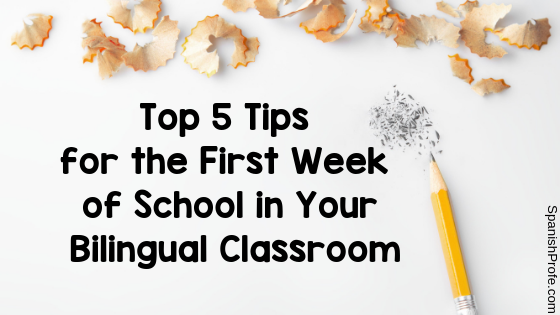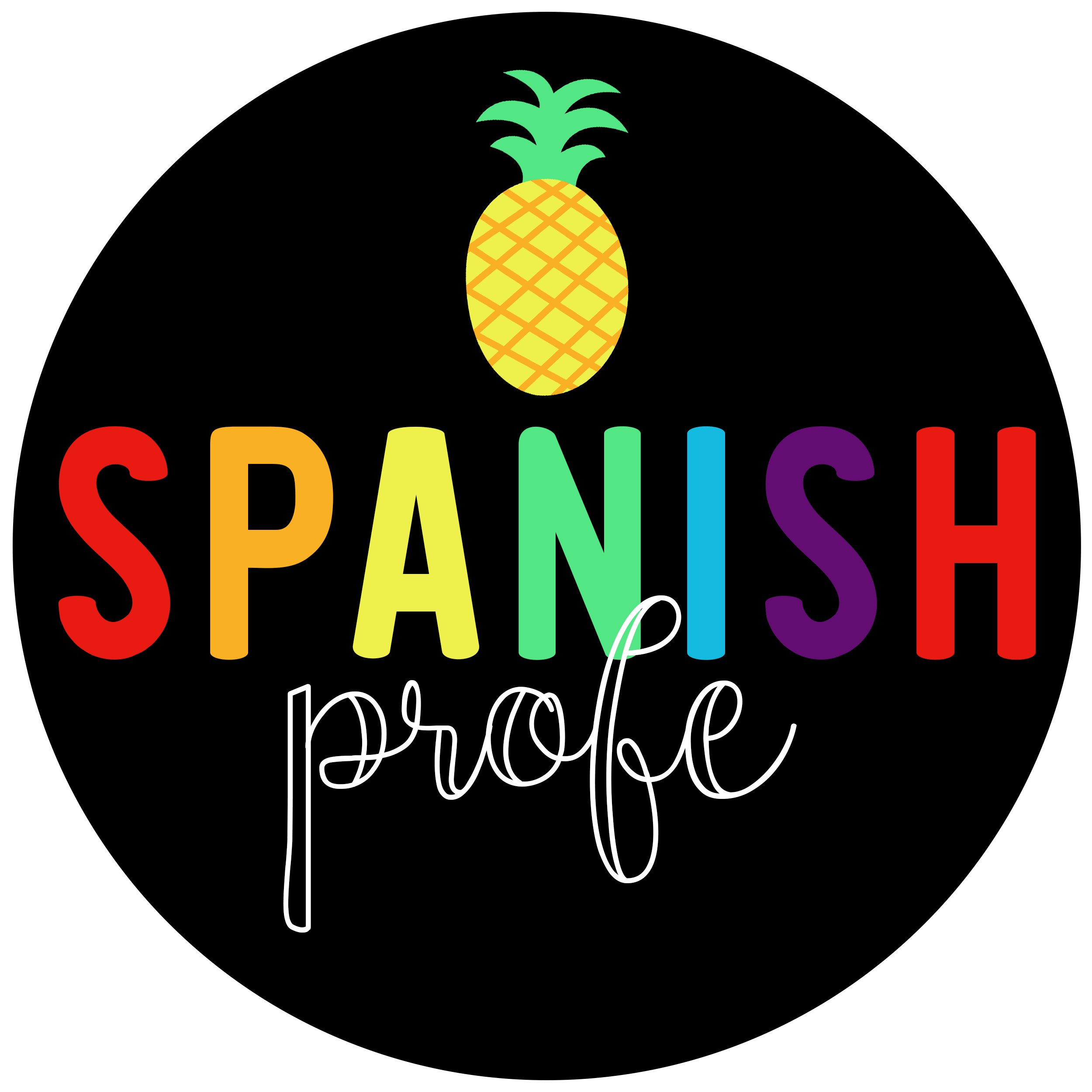
Here is a list of the top five tips for the first week of school in your bilingual or dual language classroom. The beginning of the school year is stressful, and there is a lot to remember as a bilingual classroom teacher. The following are our top five tips that help pave the path to a successful academic year in your bilingual, dual language or Spanish Immersion Classroom.
#1: Start slow. Do some activities that are introduction or review activities. Nothing too academically deep- something that helps your bilingual students ease into school.
However, I do provide an opportunity for those that would like to do enrichment activities to do so. If you are writing or practicing school vocabulary, let those kids that want to write sentences or story do that as an extension.
Start slow with simple activities that most students in the classroom should be able to do. Remember that in the summer, they often go backward in their academic knowledge, so you should be able to do something that is appropriate for them. Not necessarily coloring. It could be academically based, cutting, pasting, phonics-based or vocabulary based.
Make sure it is something that all students in the classroom should be able to be successful at.
#2: Routines, Routines, Routines.
This is the most important part of your entire year. Don’t just teach routines in your classroom one time and forget about it.
Have you ever seen classrooms in your school where all the kids in the class always seem to be following the rules or the expectations and have spectacular behavior? It is because routines are a very high priority for that teacher– something that he or she works on ALL YEAR LONG!
Be sure to go over things multiple times so that students can understand. Go over the routines it in multiple ways. You could draw a picture, or take a picture of a student doing it the correct way and have it on a board or printed out. You could have students stand up and show the class how to do things the correct way– for example how to line up or transition to tables, go to the carpet, get books or put away materials.
There are so many different routines that you need to create in your bilingual classroom to have successful classroom management and a successful year. Make sure to have a huge priority on routines and then revisit them. On the first day, if you go over routines of how to sit on the rug or the carpet and how to be dismissed; then the second date, review those routines. Keep going over your classroom routines and then introduce another routine and practice it.
As a teacher, you need to know exactly what you want your students to do. How to get their book boxes, how to work during independent or guided reading time at your tables or in small groups. All those things need to be taught, and never assume that a child knows how to do it, because you don’t know who their teacher was last year and how the classroom operated. Your expectations are obviously going to be different than they have had previously in their classroom or school year.
#3: Get to know your students.
It is so important that you build relationships with your students not just throughout the entire year, but especially during the first week because that’s often high anxiety, high emotion week for many students. Those students that don’t like school or feel uncomfortable or nervous might feel better if they know that you are invested in your relationship with them.
A great way to do get to know your students even with limited Spanish language skills in your bilingual or Spanish immersion class is sharing. I do this during the beginning of the year, as many of our bilingual students don’t remember much Spanish or they’re shy. I often do a whip share around the circle in the morning meeting.
So for example, it could be a sentence stem. (Me gusta____. or Me gusta comer ______. )
I would ask the class, “What’s your favorite food?” Then I would give examples using cognates so that those kids that aren’t very familiar with the target language or haven’t heard it in a few months can jump back in and feel comfortable with it again. I also like to have visuals for the question of the day or sharing time.
The bilingual teacher would model some examples in the TL:
I like chocolate. I like pizza. I like cereal. I like bananas. I like mangoes. Then the teachers would say, “Who can use the sentence stem? I like to eat … (Or whatever it is in your case). Let’s see who can start. Usually, someone is confident enough and volunteers right away, and then I go around the entire circle and have every single person shares using the same sentence stem. This provides students to hear common questions/words in multiple ways and feels comfortable even if they do not entirely understand what is being said. At the beginning of the school year, you’ll have a few students that copy each other. You might have like 10 out of your 25 kids say they like pizza or something like that.
It will be very helpful for you (and the other students) to learn about them. You can do just basic questions: For example: How many brothers or sisters did they have? How old are you? How did they get to school? Do they like to play soccer? Do you prefer to read or do math? Just a whole bunch of simple questions help to get to know students in a “non-academic” or stressful setting.
#4: Be consistent. You need to show that you have consistent expectations within your classroom, for academics, behavior, and for classroom routines.
If you ask students to go to the tables and you’ve already modeled this routine and shown them what to do and they don’t do it correctly, or there are children talking and that’s not part of the routine; they need to redo it. I usually have them go back to the carpet, for example, sit down and explain, “Well, I heard people talking during that transition. Let’s review, should we be talking during transitions?” They’ll say no and I usually say something like; “who thinks they can be silent like a mouse and walk to their table?” A lot of them will raise their hands and then, we do it again. At the beginning of the year, it does sometimes take two or three tries to get something right.
So you need to not be panicked that you’re not covering reading or math standards because it’s key that consistent routines and expectations are down. As a bilingual educator, you need to be very consistent in your expectations for them so that they know that what you clearly want them to do so they’re not lost and confused. That’ll make your school year a lot easier.
Also, students will feel less stressed because they’ll know what is coming up next and know what they can anticipate, and there’ll most likely be fewer behavior issues.
#5: Positive reinforcement
The last key to have to start off the beginning of the school year in your Spanish immersion or bilingual classroom grade is positive reinforcement. At the beginning of the year, we can often see right away which student(s) is going to be our troublemaker or who needs extra attention or extra support within the classroom. It’s important that you are able to give that child or all the children in the classroom positive reinforcement. So if you ask them to line up and you see … I usually just say, “Wow, Maria is doing such a great job of lining up. Just like we talked about. Pablo is doing a great job getting in line as well. Look at how quiet Marcos is. Wonderful.”
Give that positive reinforcement, especially to those kids that you know are going to need your extra attention because many love any kind of attention. Catch them doing their job. Catch them on task.
If you have a student that lays around on the floor and is under desks and out the door, find him or her doing something correctly. Whether it’s the first thing in the morning– even if he/she drives you crazy. Find something they do correctly and celebrate it. For examples: Student brought his folder right at the beginning of the day. Tell them that it is so wonderful. I’m so glad you remembered. Great job. High five.”
These were our top five tips that you need to to start the year off on the right foot and have a great year in your Spanish immersion dual language or bilingual classroom. Do you have another tip you would like to share? Leave a comment and let us know.









